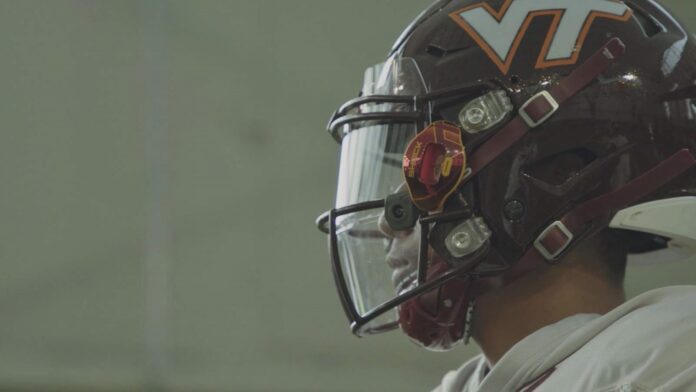Virginia Tech researchers have worked with the university’s athletic department to develop a football helmet face shield designed to block small droplets and reduce the risk of spreading COVID-19.
The university is nationally recognized for its’ work evaluating protective equipment for football and other sports, led by researchers in the Virginia Tech Helmet Lab.
“In the Helmet Lab, our driving motivation has always been reducing risk to athletes,” said Stefan Duma, the Harry Wyatt Professor of Engineering. “Historically we’ve done that by testing and evaluating helmets to protect players against head impacts, but some of the same principles helped us think about how to develop equipment to help protect them against COVID-19.”
Duma is founding director of the helmet lab and lead researcher on the project, working in close collaboration with Mike Goforth, associate athletic director, Dr. Mark Rogers, chief medical officer for Virginia Tech Athletics, and Matt Hull, a Virginia Tech research scientist and CEO of NanoSafe, a local company specializing in nanoscale exposures.
The researchers worked with Hull and NanoSafe to test the shield’s ability to block small droplets. In spray tests, the two-part visor blocked more than 99.9 percent of droplets smaller than 300 nm. N95 masks, commonly recommended for frontline workers during the pandemic, are required to block at least 95 percent of particles this size.
“This research represents the dedication and hard work of experts across the university, who came together to develop and test new equipment on a tight timeline,” said Duma. “Ongoing cross-disciplinary collaborations helped us mobilize quickly to develop a solution we’re proud to offer to our players.”
The shields are easy to assemble from commercially available components, which come pre-treated to prevent fogging. The research team is producing shields for any Virginia Tech football players who want them, and is working with other organizations to make the design more widely available.
“We need as many good ideas in the ecosystem as possible, so we wanted to make sure that whatever we designed would be easy for other schools or organizations to replicate. We used readily available materials that are easy to assemble and compatible with equipment players are already using,” said Duma.


